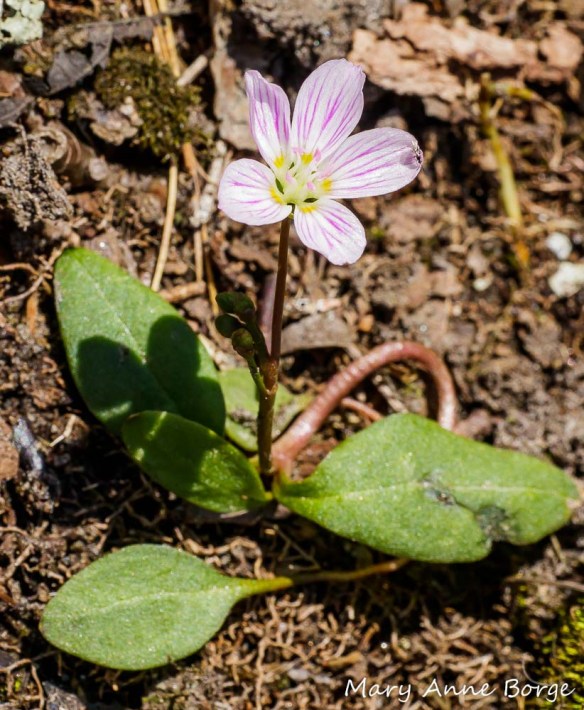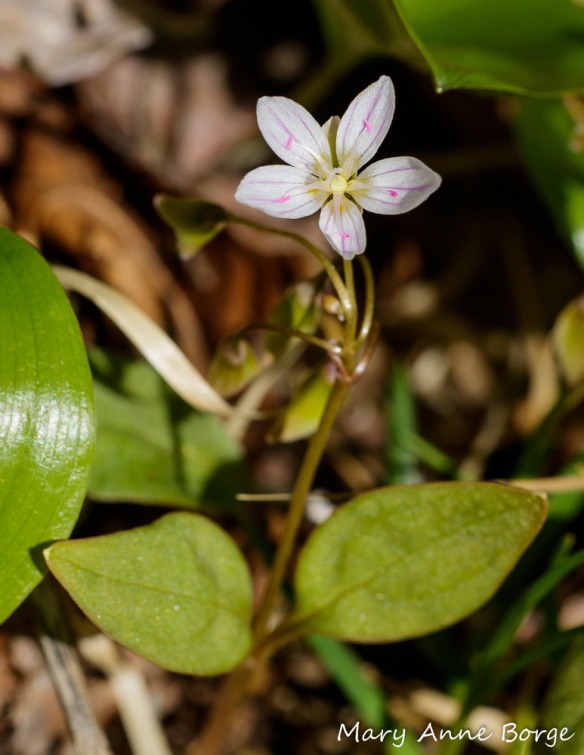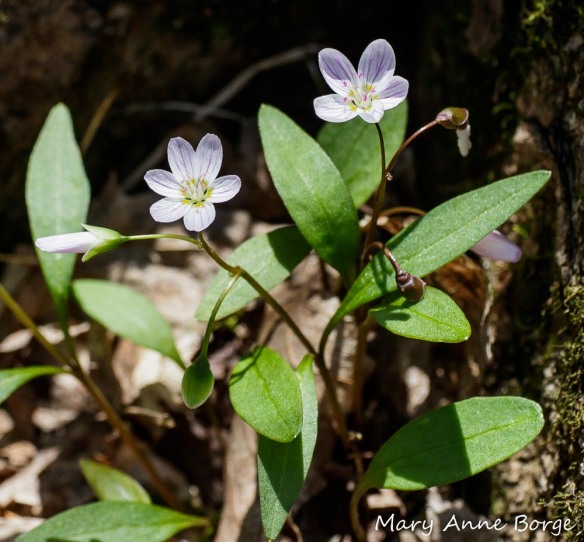Spring Beauty (Claytonia virginica) is one of the earliest of the spring wildflowers to appear in New Jersey, where I live. Its grass-like leaves emerge first, finding their way through their warm winter blanket of leaf mulch.
When temperatures are warm enough, flowers begin to bloom, offering an enticement to early spring pollinators.
I knew there was another Spring Beauty species, Carolina Spring Beauty (Claytonia caroliniana), but I never encountered it until a recent trip to Stowe, Vermont.
The flowers of the two Spring Beauty species look identical. Both have 5 white to pinkish petals, with nectar guides that vary from almost white to deep pink, striping the petals like the insect equivalent of airport runway lights, showing the way to a meal instead of a terminal.
It’s the foliage of the two Spring Beauties that set them apart. In contrast to the long, narrow leaves of Spring Beauty,
Carolina Spring Beauty has a pair of paddle or spatula shaped leaves with very distinct petioles (leaf stems).
The leaves are succulent, helping the plants through any periods of moisture shortages in the upland habitats where they are most likely to be found, according to their USDA wetland status.
Carolina Spring Beauty’s firm leaves are the perfect solar panels for this plant, gathering energy from the sun during the few weeks they appear above ground each spring.
The leaves help Carolina Spring Beauty to make the most of the short spring of its native range, which is primarily northerly or in upland areas, from Ontario to Newfoundland and Nova Scotia in Canada, south to the New England states, through the Appalachian mountains as far south as Alabama and Georgia, and in northern Michigan, Wisconsin and Minnesota. They are not found in the places I frequent in New Jersey or southeastern Pennsylvania, so it was pretty exciting to see them.
The other Spring Beauty (Claytonia virginica) has a more southerly range. It is native in Canada only in Nova Scotia and southern Quebec and Ontario provinces, then south through the United States as far as Texas in the west and Georgia in the east. The ranges of these two species rarely overlap.
Look for these Spring Beauties for a few more days, before they disappear underground until they emerge again with the first warm days next spring.
Related Posts
A Carpet of Spring Beauty, Woven by Ants
Resources
Clemants, Steven; Gracie, Carol. Wildflowers in the Field and Forest. 2006.
Spira, Timothy A. Wildflowers & Plant Communities of the Southern Appalachian Mountains & Piedmont. 2011.
USDA Plants Database – Carolina Spring Beauty
USDA Plants Database – Spring Beauty
Evergreen Native Plant Database













Just discovered your blog and am so thoroughly enjoying it. Thank you for such thoughtful, informative, and lovely work.
Thank you, Stacey! I’m so glad you’re enjoying it.
Pingback: A Lovely Native Chickweed | The Natural Web
Pingback: A Spring Ephemeral Ecosystem That Hosts Butterflies | The Natural Web
Great! Thank you for this 🙂
I’m glad you enjoyed it!
Pingback: A Dose of Spring | The Natural Web
Pingback: Bloodroot | The Natural Web
Fascinating! Such amazing photos too. Thanks, Mary Anne.
Thank you, Debby!
Oh Marianne,
The photos are just beautiful!!! Thank you! Patricia Merkel
Thanks, Patricia!